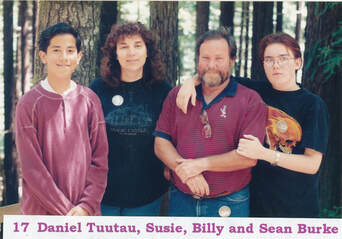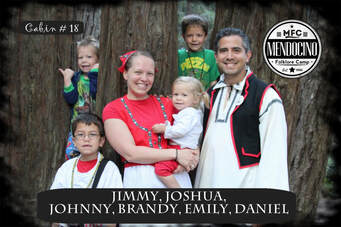MFC's Final year (adapted from an article in Let's Dance magazine, May-June 2019)
My name is Daniel Tuutau and I’m the director of Mendocino Folklore Camp. If you haven’t heard the news, 2019 is the 57th and final iteration of this week-long tradition held in the coastal redwoods of the Mendocino Woodlands.
|
I am a Tongan-American who was born in East Los Angeles, raised in South-Central LA and I currently live in Salt Lake City, UT. I am not your typical folk dancer. I was introduced to Folk Dancing by Billy Burke in elementary school. This former AMAN folk dancer committed 30 years to teaching ethnic dance to inner-city kids like me. I eventually joined TANZA, his middle-school performing troupe, where we traveled around Los Angeles presenting choreographed dances and suites to other schools. I along with some of my peers enjoyed this experience so much, that we continued to meet at Billy’s dance studio after school through our high school years to continue to perform at festivals and other local events.
The other connection I had with Billy was becoming best friends with his son, Sean. We were both 14 years old in 1997, when Sean invited me to come with his family for a week-long Camp. I had almost no idea what I was going to attend, and I definitely had no clue of the impact this event would have on my life for the next 20+ years. We left directly from our 8th grade ‘graduation’ and since then I have only missed 4 Camps (High School Graduation in 2001, 2-year Church Mission Service 2005-2006, and Touring in France 2011). From the first year I attended, I worked on the Work-Exchange Scholarship Crew, which I became the director of in 2002, and eventually, I took over as the Camp Director in 2016. |
Why end?
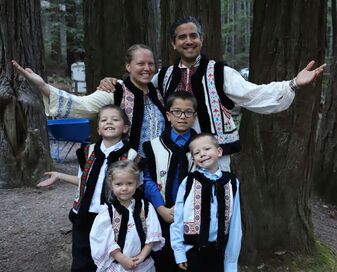 The Tuutau Family at 2019's Camp
The Tuutau Family at 2019's Camp
So how did we end up deciding that 2019 would be the final year for Folklore Camp? Really, 57 years is not a very round number to end on. I am frequently asked, What happened? Why are you closing down Folklore Camp?
For years Folklore Camp has struggled to survive. After Madelynne Greene passed, Folklore Camp had been run by a team of Directors for the next 30 years. Folklore Camp went from having a long waiting list with a surplus of funds, to breaking even, to losing a little more each year. By the early 2000s Folklore Camp looked like it was nearing its end. Susie Burke stepped in as the single director and restructured Folklore Camp, incorporating more music along with dance and keeping Camp viable for over a decade more.
In 2016 I took over for Susie and did what I could to keep the ship afloat, but there just hasn’t been enough support from both paying campers as well as those willing to volunteer as staff members. Last year, in 2018 we were faced with an enrollment of 13 full-paying campers in April, 2 months before the start of Camp. It looked as if we would have to cancel 2018’s camp. I knew that if we cancelled, not only would we be out over ten thousand dollars in deposits, but that would be the end of Folklore Camp. There would be no bouncing back from a cancellation at that late of a date.
I begin to think that what we needed was to survive for one more year, to let everyone know that this was going to be our grand finale and that we were going to go out with a BANG. However, the trick was going to be, of course, trying to survive the year. We were still desperately short on people and funds, and if we were to have held camp at that moment, we were looking at a huge financial deficit. On the day of the board meeting to discuss the future of Folklore Camp where I planned to pitch my “grand finale next year” idea, I received a call from my registrar who received a piece of mail in regards to a large sum of money that was left to Folklore Camp as part of the final estate of Honora Clark Forscutt, a long-time former director of Mendocino Folklore Camp. The amount left to Camp was just over the predicted deficit. It was seriously like something out of a Hallmark Movie.
Needless to say, with news of that donation, the board was fully supportive of my plan to give it one more go and to go out on our terms. We decided that 2019 would be Mendocino Folklore Camp’s final year.
For years Folklore Camp has struggled to survive. After Madelynne Greene passed, Folklore Camp had been run by a team of Directors for the next 30 years. Folklore Camp went from having a long waiting list with a surplus of funds, to breaking even, to losing a little more each year. By the early 2000s Folklore Camp looked like it was nearing its end. Susie Burke stepped in as the single director and restructured Folklore Camp, incorporating more music along with dance and keeping Camp viable for over a decade more.
In 2016 I took over for Susie and did what I could to keep the ship afloat, but there just hasn’t been enough support from both paying campers as well as those willing to volunteer as staff members. Last year, in 2018 we were faced with an enrollment of 13 full-paying campers in April, 2 months before the start of Camp. It looked as if we would have to cancel 2018’s camp. I knew that if we cancelled, not only would we be out over ten thousand dollars in deposits, but that would be the end of Folklore Camp. There would be no bouncing back from a cancellation at that late of a date.
I begin to think that what we needed was to survive for one more year, to let everyone know that this was going to be our grand finale and that we were going to go out with a BANG. However, the trick was going to be, of course, trying to survive the year. We were still desperately short on people and funds, and if we were to have held camp at that moment, we were looking at a huge financial deficit. On the day of the board meeting to discuss the future of Folklore Camp where I planned to pitch my “grand finale next year” idea, I received a call from my registrar who received a piece of mail in regards to a large sum of money that was left to Folklore Camp as part of the final estate of Honora Clark Forscutt, a long-time former director of Mendocino Folklore Camp. The amount left to Camp was just over the predicted deficit. It was seriously like something out of a Hallmark Movie.
Needless to say, with news of that donation, the board was fully supportive of my plan to give it one more go and to go out on our terms. We decided that 2019 would be Mendocino Folklore Camp’s final year.
One more year?
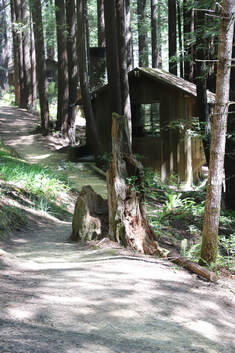 Our beloved cabin 18
Truly a rustic atmosphere
Our beloved cabin 18
Truly a rustic atmosphere
I am frequently asked, What if you get a good turn-out this year, will you reconsider? Why can’t you continue to host Folklore Camp?
We planned this final year with exact purpose of having one final good turn-out. But, if we were to continue past that, we would find ourselves right back in the same place in a few more years. We can’t hope for beloved benefactors to continue to leave Camp chunks of their inheritance year after year.
It should not come as a surprise to those active in the Folk Dance community that general interest in Folk Dancing has declined in popularity since the 1960’s and 1970’s. There are so many contributing factors that it wouldn’t do justice to the subject to try to explore them all in this article, but for camps like Folklore Camp, there are some major obstacles including cost, access, and demand.
One of the major draws of Mendocino Folklore Camp is also one of its obstacles: the rustic natural location. The Mendocino Woodlands was built in the 1930’s by the Works Progress Administration and Civilian Conservation Corps as part of President Roosevelt’s New Deal Projects. It is the only New Deal-era Recreation Demonstration Area that has continuously served its original purpose (group camping and outdoor education) uninterrupted and virtually unaltered since opening in 1938. The facility is beautiful, but it was built 80 years ago. It was not designed to fill the needs of an aging population like our Folk Dance community. Root covered paths, no electricity in the cabins, wash houses that are far away, and many other inconveniences become bigger and bigger issues with the passing years. Some camps have adjusted by moving into more urban settings where those amenities are standard. We considered this option, of moving camp to a different facility that was more ‘comfortable,’ but ultimately we decided that the location, the Woodlands, is as much a part of Folklore Camp as the dancing, the music, or the parties.
Competition is also a contributing factor: people only have so much time and money to devote to vacations. When the cost of a camp where you celebrate a foreign country costs about as much as a ticket to fly to that country, it makes a tough decision. For those not already invested in the Folk Dance community, it’s a big temporal and financial decision to take a week off from the world to try something like Folklore Camp. And for those who are invested in Folk Dance, there are other Dance & Music Camps, Foreign Country Tours, as well as Dance Cruises to grab your attention. Also, the ever-increasing cost (of both room and board) pushes Folklore Camp out of the realm of possibility for many. The younger people who have the energy to go can’t afford it, and the older people who can afford it don’t have the energy to attend. And both the young and the old struggle to find the time to make it happen.
We planned this final year with exact purpose of having one final good turn-out. But, if we were to continue past that, we would find ourselves right back in the same place in a few more years. We can’t hope for beloved benefactors to continue to leave Camp chunks of their inheritance year after year.
It should not come as a surprise to those active in the Folk Dance community that general interest in Folk Dancing has declined in popularity since the 1960’s and 1970’s. There are so many contributing factors that it wouldn’t do justice to the subject to try to explore them all in this article, but for camps like Folklore Camp, there are some major obstacles including cost, access, and demand.
One of the major draws of Mendocino Folklore Camp is also one of its obstacles: the rustic natural location. The Mendocino Woodlands was built in the 1930’s by the Works Progress Administration and Civilian Conservation Corps as part of President Roosevelt’s New Deal Projects. It is the only New Deal-era Recreation Demonstration Area that has continuously served its original purpose (group camping and outdoor education) uninterrupted and virtually unaltered since opening in 1938. The facility is beautiful, but it was built 80 years ago. It was not designed to fill the needs of an aging population like our Folk Dance community. Root covered paths, no electricity in the cabins, wash houses that are far away, and many other inconveniences become bigger and bigger issues with the passing years. Some camps have adjusted by moving into more urban settings where those amenities are standard. We considered this option, of moving camp to a different facility that was more ‘comfortable,’ but ultimately we decided that the location, the Woodlands, is as much a part of Folklore Camp as the dancing, the music, or the parties.
Competition is also a contributing factor: people only have so much time and money to devote to vacations. When the cost of a camp where you celebrate a foreign country costs about as much as a ticket to fly to that country, it makes a tough decision. For those not already invested in the Folk Dance community, it’s a big temporal and financial decision to take a week off from the world to try something like Folklore Camp. And for those who are invested in Folk Dance, there are other Dance & Music Camps, Foreign Country Tours, as well as Dance Cruises to grab your attention. Also, the ever-increasing cost (of both room and board) pushes Folklore Camp out of the realm of possibility for many. The younger people who have the energy to go can’t afford it, and the older people who can afford it don’t have the energy to attend. And both the young and the old struggle to find the time to make it happen.
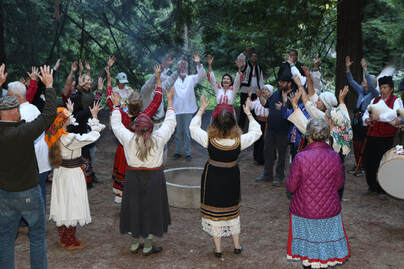
Another strength that has turned out to be a weakness is Folklore Camp’s identity. By design, Folklore Camp was not called Folk DANCE Camp. Madelynne Greene wanted the dance, music, crafts, and overall arts of these cultures to be explored and celebrated. With an ever-changing line-up of teachers each year, it’s exciting to see what will be offered from year to year. It’s the camp with a little something for everyone. That also means, it’s not locked into a certain demographic for support. There isn’t a blood-line for International Folk Dancers in the same way that there is a blood-connection for Balkan, Scandinavian, Middle-Eastern, or other cultural centered camps. If your mom is from Macedonia and your dad is from Bulgaria, you will be culturally tied to Balkan dance and music, whether you like it or not. And if you were to attend one camp, you would likely attend the one with the most connection with your cultural affiliation, not the camp that has a little of everything. Folklore Camp didn’t tie into younger generations like it needed to in order to have the support through the generations. I can attest to this since I’m still considered at times as one of the ‘kids’ at camp, even though I’m in my mid 30’s, I bring my own children, and I am the general director.
So what's next?
To help legitimize Mendocino Folklore Camp as a non-profit organization, the California Multicultural Arts Institute (CMAI) was organized as the umbrella organization for Folklore Camp, Scandia Camp, the AMAN Alumni Society, and others. It is possible for the ideas embodied in Madelynne Greene’s vision might continue to be expressed in events that carry the name Folklore Camp, or it might just fade away like so many other memories. It depends on who will step up next. CMAI is looking for interested individuals who can contribute their time, talents, and effort toward furthering the cause of culturally diverse arts in the state of California.
While Folklore Camp is finishing up, the Folk Dance and Folk Music communities will continue on. Festivals, conventions, camps, events, parties, and so forth will continue to happen in different shapes and forms as the years press on. We hope you will continue to support Folklore Traditions in your part of the word as you strive to keep the spirit of Folklore Camp alive for years to come!
While Folklore Camp is finishing up, the Folk Dance and Folk Music communities will continue on. Festivals, conventions, camps, events, parties, and so forth will continue to happen in different shapes and forms as the years press on. We hope you will continue to support Folklore Traditions in your part of the word as you strive to keep the spirit of Folklore Camp alive for years to come!

